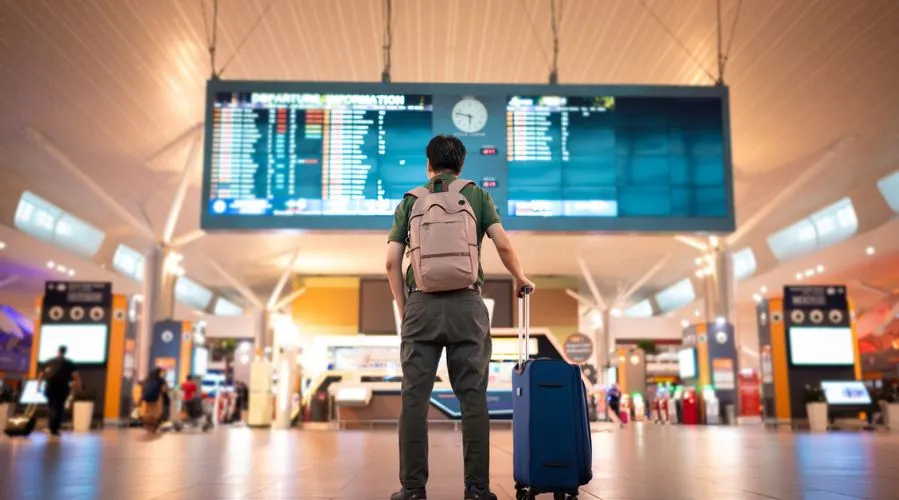Author: Anna Lorrain
Date: 09/10/2025
The travel insurance is mandatory for the issuance of a Schengen visa.
In June, the Global Peace Index (GPI) 2025 was published - an annual ranking that indicates which countries are the least safe and the safest. As always at the top: Iceland, Ireland, and Austria - the most peaceful countries. But what does the other end of the list look like? Which EU countries are considered the least safe according to the GPI 2025 and where should travelers be cautious? We provide clarity.
Table of Contents:
- Which 10 EU countries are the least safe according to GPI in 2025?
- How does the Global Peace Index measure the safety of countries?
- Why do some European countries belong to the least safe in 2025?
- What risks exist for travelers in these countries?
- What precautions should you take before traveling to these countries?
- Why choose AXA Schengen for worry-free travel?
Which 10 EU countries are the least safe according to GPI in 2025?
The least safe countries in Europe in 2025 according to the Global Peace Index (GPI) are the following. Starting with the least safe*:
- France
- Cyprus
- Greece
- Romania
- Poland
- Sweden
- Italy
- Norway
- United Kingdom
- Bulgaria
*This list only includes countries of the Schengen area and the European Union. European countries outside this area are not mentioned.
How does the Global Peace Index measure the safety of countries?
The Global Peace Index (GPI) is an annual study by the Institute for Economics and Peace (IEP). This year marks the 19th edition of the study. The index assesses global peacefulness and safety and is compiled by an international panel consisting of peace experts, peace institutes, and expert commissions. A total of 23 qualitative and quantitative indicators are evaluated, which can be grouped into these three main categories:
- Societal safety and security: this includes factors such as crime, political instability, violent demonstrations, and trust in state institutions.
- Extent of domestic and international conflict: such as ongoing wars, military confrontations, or diplomatic tensions.
- Degree of militarization: this is measured, among other things, by the intensity of armaments, military spending, and the ratio of military to civilian personnel.
Each indicator is assigned a score. The sum of all scores results in a country’s total score. The higher this score, the less safe the respective country is rated. Important pillars of peace include, among others, a well-functioning government, press freedom, low corruption rates, and solid institutions.
In short: The index provides important insights into how societal tensions, geopolitical crises, or structural problems affect the stability of individual countries.
Why do some European countries belong to the least safe in 2025?
1. France
France tops the list of the least safe countries in Europe in 2025 – and that despite being considered the world’s most popular travel destination on the other side.
Rating:
- France ranks 74th globally in the GPI, behind Tanzania and ahead of Paraguay
- The security situation is rated as “medium” with the color “yellow”
- Yearly comparison: 86th (2024), 67th (2023), 65th (2022), 32nd (2010)
- France has mostly lost ranks; in 2022, safety was still rated as “high”
Reasons:
- France has the highest degree of militarization of all countries in Western and Central Europe (7th worldwide with the highest militarization, ahead of Afghanistan and behind Saudi Arabia)
- Added to this is an increased threat of terrorism
- France also has one of the highest police presences in Europe, but it also has more serious crimes than the rest of Europe. This particularly affects Paris, Marseille, Lyon, and other major French cities. There, tourists must also repeatedly contend with activities of petty criminals.
Good to know: The Foreign Office always provides the current travel and safety advice for France.
2. Cyprus
Cyprus is the second least safe country in Europe after France – and this is mainly due to geopolitical reasons that have existed for years.
Rating:
- Cyprus ranks 68th in 2025, behind Uzbekistan and ahead of Senegal
- The security situation is rated as “medium” with the color “yellow”
- Yearly comparison: 88th (2024), 64th (2023), 67th (2022), 76th (2010)
Reasons:
- The decades-long unresolved conflict between the Greek-Cypriot south and the Turkish-occupied north continues to negatively impact the security situation to this day.
- Cyprus remains a geopolitical tension zone. The border between the two parts is monitored by UN peacekeeping forces.
- Diplomatic tensions with Turkey occur repeatedly, particularly in connection with natural gas deposits in the Mediterranean.
- Despite a low crime rate, Cyprus is poorly rated in the Global Peace Index due to the latent war risk, high militarization, and fragile political balance.
3. Greece
Rating:
- Greece ranks 45th in 2025, behind Timor-Leste and ahead of Argentina
- The security situation is rated as “high” with the color “green”
- Yearly comparison: 40th (2024), 60th (2023), 53rd (2022), 62nd (2010)
- Greece has improved the second most since 2014
Reasons:
- Greece continues to struggle in 2025 with economic and social challenges that affect internal security.
- Although the economy has slightly recovered, high unemployment, growing poverty, and unstable political conditions foster protests and distrust toward state institutions.
- The proximity to Turkey, with which regular disputes over maritime boundaries and airspace arise, further exacerbates the situation.
- Ongoing tensions surrounding migration and asylum policies – particularly on islands like Lesbos – intensify polarization within the population.
4. Romania
Rating:
- Romania ranks 38th in 2025, behind Mongolia and ahead of Vietnam
- The security situation is rated as “high” with the color “green”
- Yearly comparison: 36th (2024), 31st (2023), 31st (2022), 45th (2010)
Reasons:
- Romania repeatedly struggles with corruption and weak rule of law
- Organized crime and social inequality contribute to insecurity
- Although Romania experiences no acute military threats, the internal political situation is tense
- In the area of militarization and internal and external conflicts, Romania ranks in the global midfield
5. Poland
Rating:
- Poland ranks 36th in 2025, behind Sweden and ahead of Mongolia
- The security situation is rated as “high” with the color “green”
- Yearly comparison: 32nd (2024), 29th (2023), 25th (2022), 29th (2010)
Reasons:
- Poland has experienced increasing political polarization in recent years. The government’s judicial reforms and strained relations with the EU have led to massive protests and international tensions.
- The conflict at the border with Belarus, where refugees were used as “political leverage,” has further aggravated the national security situation.
- The strong militarization – particularly in the context of the Ukraine war – also influences the GPI score.
What risks must travelers watch out for in these countries?
Even though countries like France and Cyprus are among the “less safe” countries in Europe, this does not mean they are fundamentally dangerous or to be avoided by tourists. Many of the risks are regionally limited, politically motivated, or primarily affect locals. Nevertheless, you should inform yourself well – especially for city trips, individual travels, or tours off the classic tourist paths.
Risks for Tourists in France
France remains the most visited country in the world – with over 100 million visitors per year.. The police presence is high throughout France, and travel routes across the country – such as in Provence, along the Côte d’Azur, or in the Loire Valley – are considered safe. Nevertheless, as a tourist, you should observe the following recommendations:
- Strikes and Demonstrations in France: Metropolises like Paris, Marseille, or Lyon regularly experience demonstrations, sometimes with violent outbreaks. Particular caution is advised on weekends or during political crises. We therefore recommend being attentive on-site, informing yourself through local media, and following the instructions of local authorities.
- Petty Crime in France (pickpocketing, scams) is widespread in tourist hotspots like Montmartre, around the Eiffel Tower, or at train stations. Be especially careful in the metro and in local and long-distance traffic. There is also an increased risk in night trains with sleeping and couchette cars in southern France. Violent crimes are rare, but they do occur (for example, there have been repeated waves of needle spiking attacks at festivals or in clubs across France in recent years).
- Terrorism in France: Terrorism remains a threat in Europe - including in France and especially in Paris. Particularly when you are at public places or attending large gatherings. Further information on the terrorist threat in France is available from the French Ministry of the Interior.
- Assaults on Vehicles in Road Traffic: Do not overnight at rest stops and highway service areas, as there has been an increasing number of activities by organized gangs. Particularly from the regions Auvergne-Rhône-Alpes, Provence-Alpes-Côte d'Azur, and the eastern part of the Occitanie region.
More Information: You will find more information for your trip to France in our article on travel advice and tips for France.
Risks for Tourists in Cyprus
Travel to Cyprus is generally considered safe. The tourist-developed regions in southern Cyprus, such as Larnaca, Limassol, or Paphos, are quiet. The “unsafe” part almost exclusively concerns the internal political division of the island. Observe the following travel advice:
- Avoid Demonstrations and Large Gatherings: Sporadic social tensions can lead to outbreaks of violence and other acts of aggression.
- The Republic of Cyprus only exercises control over the southern part of the island: Travelers should inform themselves about the political situation during trips to the north (Turkish Republic of Northern Cyprus) and stay on official crossing points.
- Buffer Zone with Minefields: The line between the two parts is monitored by the UN. Minefields are present on both sides of the demarcation line.
- Petty Crime: Particularly in tourist areas and on beaches, pickpocketing and car break-ins occur. Avoid unlit streets and lonely areas.
Good to know: Here you will find the current travel and safety advice for Cyprus from the Foreign Office.
Risks for Tourists in Greece
Greece is a popular vacation destination, and regions like Crete, Rhodes, the Cyclades, or the mainland around Thessaloniki are very safe. The following recommendations are nevertheless made for Greece:
- Political Activity and Protests: Athens, especially the Exarchia district, is known for political activity, protests, and a certain hostility toward police. Inform yourself in advance through local media.
- Pickpocketing and Snatch Thefts: are very common. Particularly in Athens, many thefts of wallets and passports are reported, especially in the metro between Athens airport and the city.
- On some Aegean islands, especially near the Turkish border, refugee camps can lead to tense situations.
Good to know: Here you will find the current travel and safety advice for Greece from the Foreign Office.
Risks for Tourists in Romania
Romania attracts the country with its authentic culture, affordable prices, and hospitality more and more individual tourists. Those who travel with common sense usually move safely here as well. Therefore, observe the following advice:
- Organized Petty Crime: particularly pickpocketing and snatch thefts in Bucharest or at train stations are common. Use your credit card with caution. Always keep money, passports, driver’s licenses, and other important documents safely with you.
- Tension due to Proximity to Ukraine: Due to the Ukraine war, tensions in the region remain high. Therefore, follow the information and instructions of local authorities.
- Weak Infrastructure: In rural areas, the infrastructure can be weak, such as in Transylvania or parts of the Carpathians.
Good to know: Here you will find the current travel and safety advice for Romania from the Foreign Office.
Risks for Tourists in Poland
Poland is an attractive destination with high standard safety. In major cities like Warsaw, Krakow, or Gdansk, there are no significant issues, although you should of course also watch out for pickpockets here.
- Border Area to Ukraine: Due to the war against Ukraine, tensions in the region remain high. There have already been stray rocket strikes in the past.
- Border Regions to Belarus: there has recently been increased military presence and restrictions – these areas should be avoided.
Good to know: Here you will find the current travel and safety advice for Poland from the Foreign Office.
What precautions should you take before traveling to these countries?
Those who observe a few key precautions can effectively minimize many risks and enjoy a safe, relaxed stay.
- Stay Informed: before and during the trip
Before departure, you should inform yourself about the current security situation in the destination country. You will find always up-to-date travel advice on the official websites of foreign ministries or embassies.
Tip: Subscribe to travel warnings via e-mail or use travel apps with security notifications (e.g., “Safe Travel”, “Smart Traveler”)
- Register with Your Embassy
Many states offer voluntary travel registration for citizens traveling abroad. In a crisis or emergency (e.g., natural disasters, political unrest), the embassy can thus make contact.
- The European Emergency Number: 112
Note the emergency number 112! It is free and available 24/7 throughout Europe – both via mobile and landline. It applies to police, fire department, and rescue services and is also dialable without a SIM card. In serious situations, this is your first point of contact for help during European travels.
- Cautious Behavior on the Go
- Avoid crowds (e.g., demonstrations)
- In cities, be especially careful with personal belongings at train stations and public transportation
- Do not carry valuables visibly (e.g., camera, jewelry, large bills)
- Inform yourself about “no-go areas” upon arrival at the hotel or hostel
- In road traffic, increased caution applies in some countries – such as in Italy, Bulgaria, or Romania, where driving style, road conditions, and traffic rules vary greatly.
- Don’t Forget Travel Insurance
An absolute must before any trip abroad is the conclusion of travel insurance that covers medical care, repatriation, luggage loss, and cancellation. Especially in unsafe areas or politically unstable destinations, comprehensive protection makes a difference.
Learn more now: Travel insurance for France Travel insurance for Greece
Why choose AXA Schengen for worry-free travel?
AXA Schengen offers reliable and recognized travel insurances that not only meet the requirements for Schengen visas but also cover medical emergencies, repatriations, hospital stays, and much more. Simply choose from our various policies, all of which are Schengen visa compliant:
- Basic Travel: Minimum coverage of 30,000 € for a Schengen visa application and valid in all Schengen countries.
- Essential: Comfortable coverage of 100,000 € for a stay in Europe, valid in all Schengen countries, EU countries (including European microstates), and the United Kingdom.
- Premium: All-inclusive with coverage of 2,000,000 €: No worries, everything is included - even travel luggage insurance. Valid in all Schengen countries, EU countries (including European microstates), and the United Kingdom.
- Annual: Annual insurance, ideal if you plan multiple trips to Europe in a year. Valid in all Schengen countries, EU countries (including European microstates), and the United Kingdom.
Thanks to easy online booking and immediate insurance confirmation, AXA Schengen offers a secure and flexible solution – whether you are planning a city trip to Paris, a beach vacation in Cyprus, or a cultural journey through Eastern Europe. Travel with peace of mind and protected, because if something happens, we are your trusted partner on-site and 24/7 for you!
Get your free online quote now.
Related Articles
These articles might also interest you
- Travel advice and tips for Germany
- How safe is Spain? Risks and travel advice for Spain
- What are the most common scams in Europe
- The most disappointing tourist attractions in Europe
FAQ
Which countries are the safest in Europe in 2025?
According to the Global Peace Index 2025, Iceland (1st place), Ireland (2nd place), Austria (4th place), and Switzerland (5th place) are the safest European countries. Thus, four European countries are among the top 5. These countries were already among the top 5 safest worldwide in 2024.
Where does Germany stand in this Global Peace Index list?
Germany is 20th in the Global Peace Index in 2025 and is classified with the security level “High.” Germany thus ranks behind Croatia and ahead of Bhutan. Compared to 2024, Germany has lost 3 places (2024: 17th).
Why is travel insurance useful in unsafe countries?
In countries considered less safe, the likelihood that something happens to tourists is higher. Whether it’s the theft of important documents or an accident due to a scuffle - comprehensive travel health insurance helps you in all cases - with medical consultation as well as with obtaining new documents.
AXA already looks after millions of people around the world
With our travel insurance we can take great care of you too

AXA Schengen Basic
AXA Schengen Basic is perfect to obtain your Schengen visa. This travel insurance meets all the requirements demanded, covers you in all the countries of the Schengen Area as well as 4 European microstates (Andorra, Vatican City, Monaco and San Marino).

AXA Schengen Essential
AXA Essential is perfect to obtain your Schengen visa. It provides coverage in all the Schengen countries + the European microstates + all the EU countries (including UK, Cyprus and the Republic of Ireland). And you get additional guarantees compared to AXA Schengen Basic.

AXA Schengen Annual
AXA Annual is perfect to obtain your Schengen visa. This annual travel insurance is ideal for those who often travel to Europe as well as multiple-entry Schengen visa holders. You get the same guarantees as AXA Schengen Annual for different countries during 90 days.


